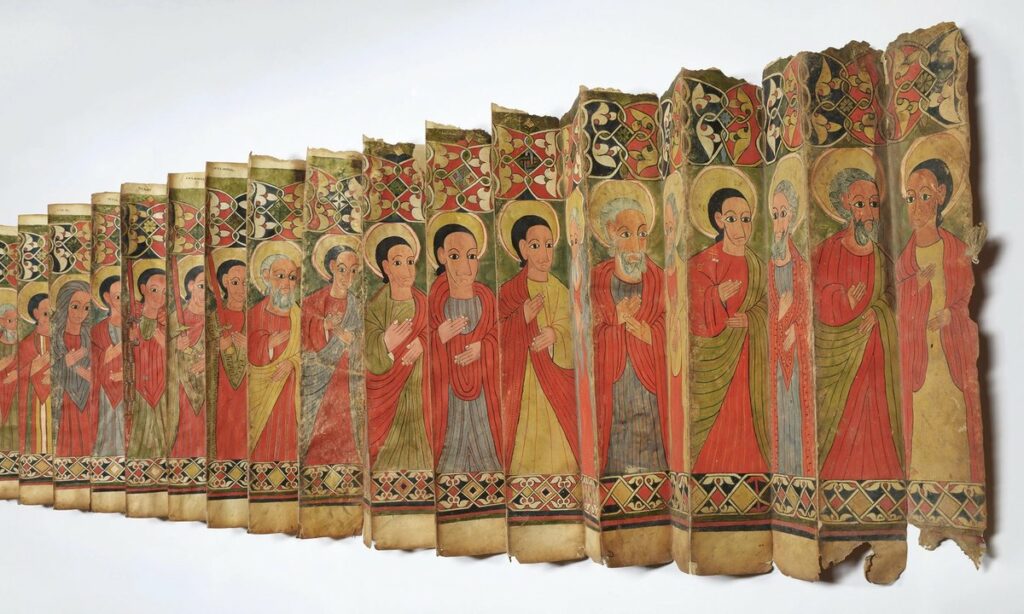The Walters Museum of Art, which holds one of the most extensive collections of Ethiopian art outside of Ethiopia, is hosting a major US exhibition of 1,750 years of art from the Horn of Africa. Ethiopia at the Crossroads will feature more than 200 objects—just under half from the museum’s own collection—including ancient stone sculptures, coins, icons, paintings, processional crosses, illuminated manuscripts, healing scrolls and basketry, as well as works by contemporary Ethiopian artists such as Wosene Worke Kosrof, Aida Muluneh and Elias Sime.
More than three-quarters of the works on display will be from Ethiopia, while the rest will provide context for the nation’s rich cultural connections to places such as Coptic Egypt, South Arabia, Byzantium, Armenia, Italy and India. There will also be objects related not only to Christianity—Ethiopia was one of the first nations to adopt the faith as its official religion in the fourth century—but to Judaism and Islam too.
“I pitched the idea for this show at my job interview six years ago,” says Christine Sciacca, the show’s curator, who specialises in Ethiopian, Italian and German illuminated manuscripts. As part of the exhibition, the museum is handing out scratch-and-sniff cards that conjure Ethiopian food and culture along with an “Ethiopian manuscript” scent. “It’s very specific,” says Sciacca, who was already aware of the vast Ethiopian collection at the Walters and is now excited to place it in a wider global history. But how did Ethiopian art end up in Baltimore in the first place?
Tightrope (2021) by Elias Sime, a contemporary Ethiopian artist, will be on show at the Walters Photo: Phoebe d’Heurle, Courtesy of the artist and James Cohan
In the late 1980s and early 90s, Gary Vikan, a trained Byzantinist who was an assistant director at the Walters at the time, hoped that a special exhibition of Ethiopian art would engage the large Ethiopian diaspora and Black communities of Baltimore and nearby Washington, DC. African Zion: the Sacred Art of Ethiopia, composed primarily of works borrowed from other institutions, opened at the Walters in 1993 as the first major exhibition of Ethiopian art in the US. It was such a success it toured seven other US museums.
“After that, collectors started to give us Ethiopian art, and we bought works as well,” Sciacca says. She remembers using the African Zion exhibition catalogue as a textbook at university. Vikan became director of the museum in 1994—a post he held until 2013—and today the Walters has more than 200 Ethiopian works in its collection.
Like African Zion, Ethiopia at the Crossroads will seek to involve the local Ethiopian diaspora, but more as a collaborator than was the case 30 years ago. In the six years it has taken to prepare the exhibition, Sciacca says that advisory committees composed of local Ethiopians and Ethiopian Americans were continuously consulted. A major worry that came out of these meetings was the provenance of the objects on display.
An evangelist by an unidentified artist, Ethiopia, 16th century
“We were really careful with this show,” Sciacca says. “I’ve been to museums in the UK with objects looted from the Battle of Maqdala, and we didn’t ask to borrow them for this show”. The 1868 battle resulted in the pillaging of numerous works, the most famous of which was the holy icon Kwer’ata Re’esu, now in a private collection in Portugal.
“We have loans from the British Museum, but not the Maqdala pieces,” Sciacca says. She adds that even though the exhibition would have benefitted from having these works on display, such a “clear case of looting” could not be overlooked. The collection of the Walters has been thoroughly vetted and provenance information for all its objects is publicly available. There is even a whole wall panel in Ethiopia at the Crossroads devoted to the concept of provenance—what it means and why it is important.
Sciacca says that one of her favourite works in the exhibition is a “big piece of parchment from the late 15th century, 154 inches long, which is foldable like an accordion but will be extended in the gallery into a fan shape”. On the parchment are painted more than 30 saints, with each fold devoted to a single icon. “There are only six of these parchments that survived,” Sciacca says. “And this is the only example outside of Ethiopia.”
Ethiopian Emperor Haile Selassie’s royal cloak from the early 20th century
Jumping ahead to the early 20th century, another highlight is a royal cloak that belonged to Haile Selassie, the last Ethiopian emperor who traced his lineage back to Solomon and the Queen of Sheba, the founding parents of Ethiopia, who appear repeatedly throughout the exhibition. A descendant of Haile Selassie gave the cloak to a US diplomat, who donated it to the museum in 2003. “We’ve never had it on view before,” Sciacca says, adding that, as the last emperor is a deity to Rastafarians, the cloak may draw many followers to the museum to see it. More generally, she hopes “the exhibition helps open people’s eyes to Ethiopia”.
• Ethiopia at the Crossroads, Walters Art Museum, Baltimore, 3 December-3 March 2024; Peabody Essex Museum, Salem, 13 April-7 July 2024; Toledo Museum of Art, Ohio, 17 August-10 November 2024
Source link : https://www.theartnewspaper.com/2023/12/01/sacred-ethiopia-from-medieval-icons-to-haile-selassies-cloak
Author :
Publish date : 2023-12-01 03:00:00
Copyright for syndicated content belongs to the linked Source.
